Rose is the capricious queen of the front garden, which strikes with its beauty during the flowering period of any gardener. Curly or climbing roses are no less capricious, but also beautiful, they have long shoots dotted with flowers - they raise buds to any height. These roses are often used to create vertical design compositions, decorating gazebos on a personal plot. Curly roses throughout Russia cannot grow year-round due to climatic conditions. Because you need to know how harbor a climbing rose for the winter and how to prune the plant for rapid growth and lush flowering in the next season.
Content
Care for climbing roses in autumn
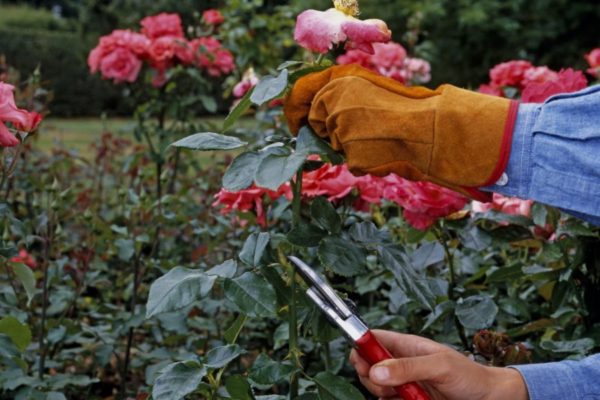 A climbing rose, like other open ground plants, ends its vegetative period in the fall, but preparations for winter should begin in mid-August.
A climbing rose, like other open ground plants, ends its vegetative period in the fall, but preparations for winter should begin in mid-August.
Preparing for the winter in the climbing roses and autumn care includes:
- fertilizing with nitrogen fertilizers is stopped in August. Because they stimulate the active growth of greenery;
- in September, stop additional watering and loosening of the soil;
- at the end of September, a dose of phosphorus-potassium fertilizer is introduced into the soil to strengthen the root system and the aerial parts of the plant.
By preparing roses for winter you need to carefully clean the bush. From it you need to remove all buds, flowers, leaves, damaged and broken shoots.
Trim value
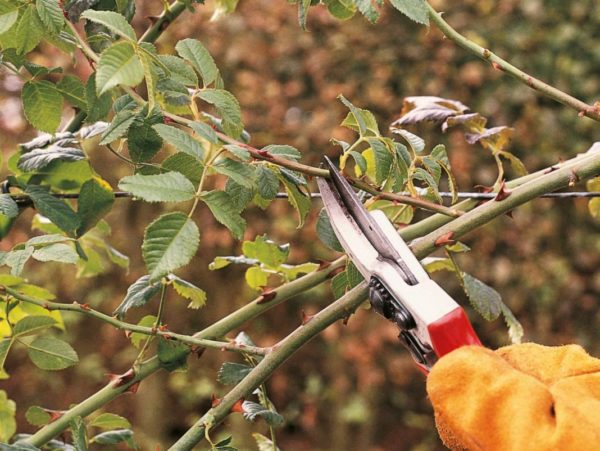 Curly roses can be of various types, depending on why the most convenient way of pruning is determined. In order for the procedure to benefit the capricious plant, it must be trimmed regularly in the fall.
Curly roses can be of various types, depending on why the most convenient way of pruning is determined. In order for the procedure to benefit the capricious plant, it must be trimmed regularly in the fall.
Preparing a climbing rose for winter necessarily includes pruning, which is necessary for:
- removal of old lashes;
- complete rejuvenation of the bush;
- thinning the bush in order to form its homogeneity;
- lush flowering in the summer of next year;
- full distribution of nutrient components from the aerial parts of the plant to the underground;
- increase of protective qualities and activation of resistance to various diseases and pests;
- gives high-quality material for division.
If the bush is not trimmed for 2-3 years, it will often begin to hurt, bloom less and completely die in 5–7 years. Beginning flower growers are often afraid to harm the plant using sophisticated pruning methods; there is a solution. To get started, you just need to remove the height of the bush about twice or more and remove all old and damaged shoots at the base. Simple pruning will help update the bush without any risks.
Winter pruning
Ordinary bush roses are pruned according to the principle - the lower the better. In the case of a climbing rose, this technique does not work. A cut in the wrong place will cause a lag in the development of the plant, a decrease in decorativeness, stretching of the lashes, late flowering or its complete absence.
Winter pruning carried out after the temperature drops to -3 degrees at night. In central Russia, this happens in late October or early November.If pruning is carried out earlier, the growth of new shoots is possible, which will certainly die in the winter. Some novice gardeners try to prune late summer, but this is not true. The plant does not have time to lignify before frost and dies; after warming, the resulting rot will become soil for the growth of bacteria.
Cropping differences by grade
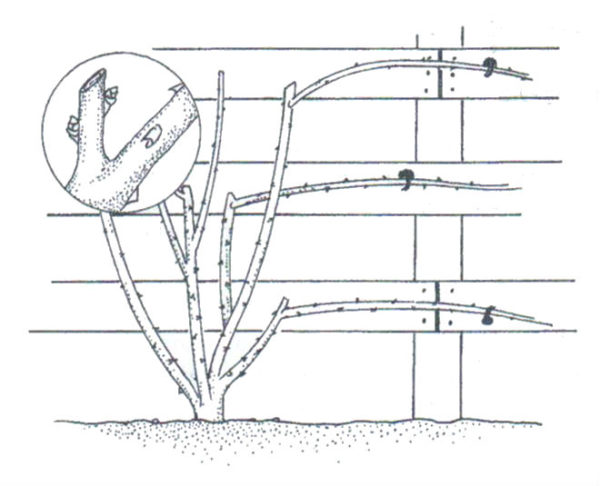 Trimming recommendations vary according to the Queen of the Garden variety:
Trimming recommendations vary according to the Queen of the Garden variety:
- Early flowering varieties - Excelsia, Dorothy, Perkens. Damaged roots are removed from the purchased seedling and all stems with a length above 30 cm are removed, shortening them. Immediately after flowering, long shoots grow from the bush. Which you need to try to form horizontally. The next year, on horizontal shoots, vertical ones are formed, studded with buds. Flowering shoots this year need to be removed. A bush of a climbing rose can be called fully formed for 2-3 years.
- In plants of the second group, basal shoots are poorly formed, therefore old ones are removed only after the formation of new ones. After the purchase, dry roots are removed from the seedling and long stems are removed. In the second year, the plant opens buds on young shoots.
- A group of roses with long, flexible stems. Blossom on last year's shoots. Care consists in pruning the plant after flowering, a cut should be done for 2-3 buds. Lateral shoots need to be tied, weak ones should be removed - the plant will not bloom on them.
- Pyramidal with vertical growth. After the purchase, pruning of weakened and damaged shoots is carried out, the root ball is reviewed. Healthy stems reinforce to support. After flowering, the side shoots with buds are cut to the base. The next year, flowers bloom on the side shoots of last year, after flowering they are cut to a length of 15 cm at the base.
- Strong-growing thick bushes with shoots up to 6 m long. Form horizontally and vertically. Pruning of old shoots is carried out annually. Side shoots are removed selectively.
Observance of pruning rules will allow you to get lush flowering and see how the rose weaves and grows rapidly next season. The main condition that ensures the successful implementation of the procedure is the temperature regime and proper wintering.
Top dressing after autumn pruning
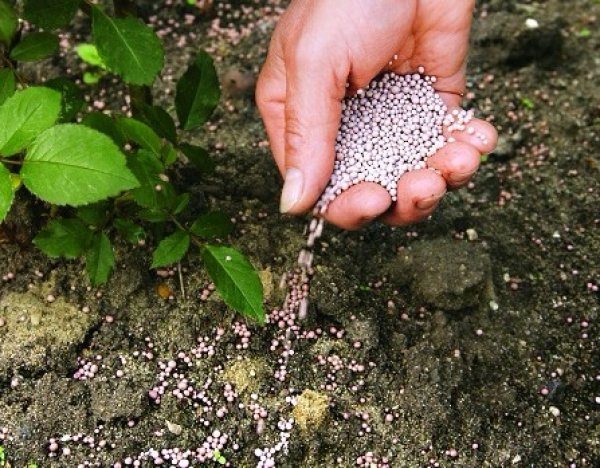 The last time during the season, the rose bush is fed precisely after pruning, but you need to wait about 2 weeks to stabilize the plant. If in the summer nitrogen fertilizers are used for regular top dressing, then after the buds are dissolved, this component must be removed from the nutrient mass. It stimulates the growth of flowers and shoots. In autumn, it is better to feed with a high content of phosphorus and potassium - such remedies strengthen existing shoots. But they stop the growth of new ones, do not provoke flowering.
The last time during the season, the rose bush is fed precisely after pruning, but you need to wait about 2 weeks to stabilize the plant. If in the summer nitrogen fertilizers are used for regular top dressing, then after the buds are dissolved, this component must be removed from the nutrient mass. It stimulates the growth of flowers and shoots. In autumn, it is better to feed with a high content of phosphorus and potassium - such remedies strengthen existing shoots. But they stop the growth of new ones, do not provoke flowering.
Since the plants are weakened in the fall, it is recommended to apply mineral fertilizer in moist soil, in the evening after sunset - such conditions will help the queen of the flower garden to leave for winter peace smoothly and without injuries.
Necessary equipment for trimming
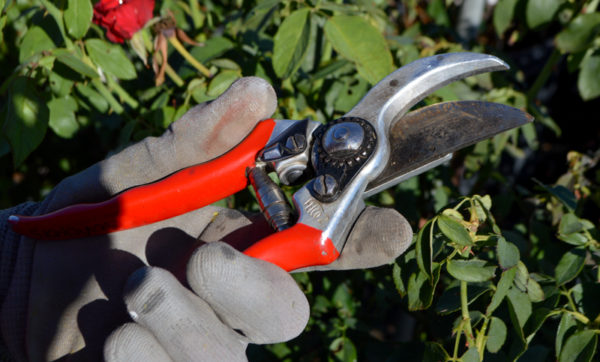 To trim you need the following set of tools and accessories:
To trim you need the following set of tools and accessories:
- secateurs of different sizes and strengths - for large, old branches you need a massive one;
- folding saw, with the ability to change the angle of the blade;
- secateurs with one cutting end;
- Teflon gloves (long);
- folding rake.
For convenience, you can buy lining under the knees. They are made of different materials. They can be called an indispensable thing for working in the garden.
Secateurs of different sizes are necessary for accurate work. It is difficult to grab and chop without damaging a large branch with a small device. Working with young shoots requires caution because it is better to work with a thin-blade pruner.
When to trim
When considering the pruning process, it should be mentioned that curly roses can bloom on last year's or young branches. This is the main condition that is taken into account when caring for a plant. Ramblers give color only on last year's branches, because they are pruned in the fall after the completion of the vegetative cycle by flowering. Dry inflorescences are necessarily removed.
Climmers bloom on young branches, whose age is no more than 1 year, therefore pruning is recommended to be carried out in early spring after the air temperature in the daytime and at night is kept at around 2 degrees. Pruning at a time when night frost is possible is unacceptable, frost will “pick up” slices and they will not give growth and flowers. No less dangerous problem is the rot formed as a result of fungal infection, therefore, after formation it is necessary to treat the plant with a fungicide.
Preparing a climbing rose for winter
Curly roses have long shoots that are covered with sharp thorns along the entire length - this condition complicates the process of sheltering the plant for the winter, therefore they need to be pruned. The mistake that beginning flower growers make is pruning under the root. This action leads to a lack of flowering for the next year. The bush will be forced to build up new shoots and gain strength. The loss of all the aboveground mass is detrimental to the plant, therefore the possibility of its death cannot be ruled out. Since roses are often affected by fungus, it must be treated with fungicide before shelter, a solution of copper sulfate is suitable.
Help ripen the shoots
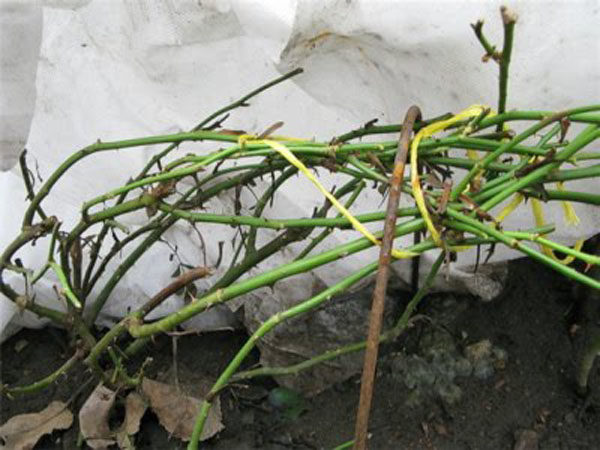 The climbing rose during the flowering period looks amazing, because inexperienced flower growers try to extend it, making a dangerous mistake. If the rose retains flowers until the frost itself, it may not tolerate winter, therefore, fertilizing with nitrogen-containing fertilizers should be stopped already in August.
The climbing rose during the flowering period looks amazing, because inexperienced flower growers try to extend it, making a dangerous mistake. If the rose retains flowers until the frost itself, it may not tolerate winter, therefore, fertilizing with nitrogen-containing fertilizers should be stopped already in August.
Early refusal to feed will help stop the growth of young shoots - they will not ripen to frost and die regardless of shelter. Death involves the decay of young branches, and then a fungal infection spreads throughout the bush.
No need to loosen and dig up the soil between plantings - a common cause of damage to the root system and the awakening of sleeping kidneys underground.
Shelter for the winter
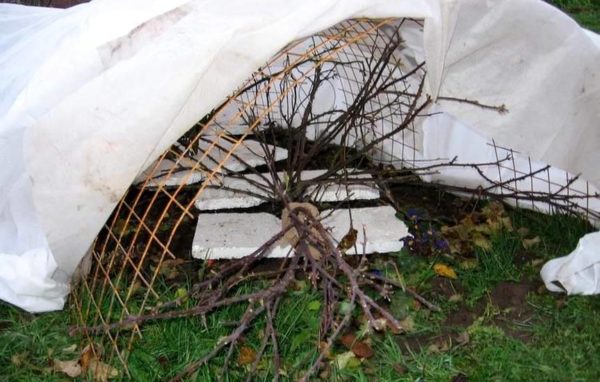 The main problem is that flower growers try to cover the plant before the onset of frost, believing that the rose does not tolerate frost. This is a mistake and all varieties can withstand night-time temperature drops of -5 degrees, and the most common, non-collection varieties of up to -10.
The main problem is that flower growers try to cover the plant before the onset of frost, believing that the rose does not tolerate frost. This is a mistake and all varieties can withstand night-time temperature drops of -5 degrees, and the most common, non-collection varieties of up to -10.
A small freeze is a necessary element of the process of hardening the plant, therefore, one should not rush into the construction of a shelter for the favorite of the front garden. Recommended shelter dates can vary significantly depending on the landing region, for example, in the middle lane, shelter should be built by the end of October, while in the Urals, a rose should be hibernated at the end of September.
Cleansing of debris and strengthening immunity
In early September, the space under the bushes should be cleaned of debris and weeds, because in winter they will become a nutrient substrate for the development of fungal spores. To increase immunity, the plant must be sprayed with fungicide. Gardeners prefer Fitosporin. After the first treatment and cleaning of the soil from litter, the plant is removed from the supports and laid on the ground.
It is difficult to remove an adult bush from a support; therefore, doing it alone should not be. It is important to carefully remove all lashes without damaging them. At the site of injury, the plant needs to be cut.
Hilling
The process of hilling is better to start with sheltering the root neck - a simple technique will help protect the bush from adverse conditions. For hilling take dry soil. To shelter the roots of a young bush, about 1 bucket of land will be required, an overgrown plant requires 2-4 buckets. The earth is poured into the center of the bush in the form of a cone.
How to cover a climbing rose for the winter
Shelter of roses for the winter - a troublesome task, therefore it is necessary to engage in the construction of protection from the cold in advance. There are several ways to prevent freezing and decay of the bushes. The optimal method can be selected depending on the type of shrubbery, its size and volume of plantings.
Air dry method
This method is the newest of all existing. A frame is created around the perimeter of the rosary, on which boards are subsequently laid, and material for shelter is placed on it. This method is convenient to use for sheltering large areas, one structure solves the problem with all landings. Separately growing shrubs will have to be sheltered by other methods.The advantage of this method is durability, all materials used can be stored and reused for the next wintering. The method has one significant drawback - low strength. Therefore, it cannot be used in regions with large snow cover, the design may fail on the rose garden.
Shields for roses
The principle of the method is that the bush, removed from the supports, is pulled together in a bundle and laid on spruce branches attached in several places with a flexible wire to the ground. Wooden panels are constructed from improvised materials, for example, wood, with a width of 80-90 cm. Such panels are laid along the rosary on both sides in the form of a "house roof". Top cover with a layer of polyethylene. Before severe frosts, the film at the ends of the structure is kept open, after freezing to -10 degrees during the day, the rose garden is tightly closed.
The advantage of this method is its adaptive qualities. In autumn and spring, when the temperature remains stable, the structure can be ventilated, which prevents the steaming of plants. The disadvantage is the large construction costs.
Frame shelters
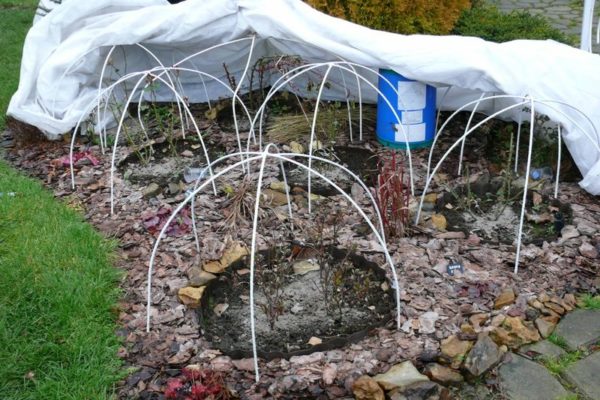 The frame for this shelter can be made of dense wire or wood. Branches roses are fixed at the support so that they do not come into contact with metal. For shelter use non-woven material, which is covered with a film to protect against rain. Comparing this method with the previous ones, one can note its failure - there is a high risk of rotting the crop. The construction must be constantly aired.
The frame for this shelter can be made of dense wire or wood. Branches roses are fixed at the support so that they do not come into contact with metal. For shelter use non-woven material, which is covered with a film to protect against rain. Comparing this method with the previous ones, one can note its failure - there is a high risk of rotting the crop. The construction must be constantly aired.
Conclusion
Correctly prepare a climbing rose for winter by following simple instructions. Violation of the described recommendations will lead to problems of a different nature, the plant may not bloom in the season, form incorrectly or simply not survive the winter. To make the rosebush happy every year, you must strictly follow the recommendations for pruning and shelter for the winter.

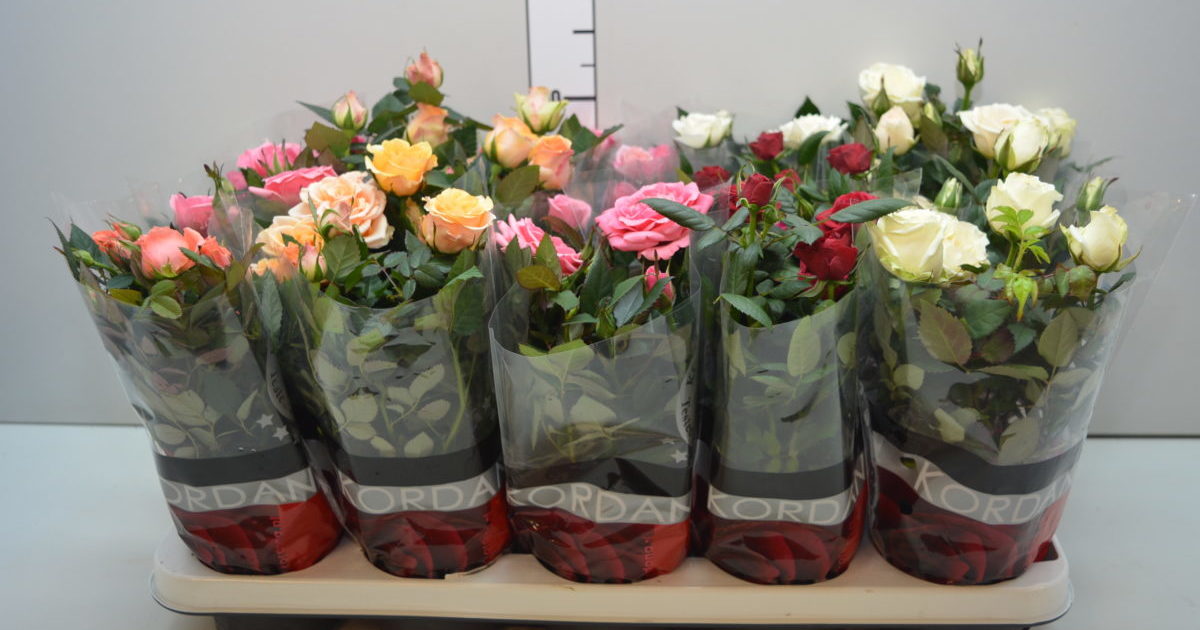
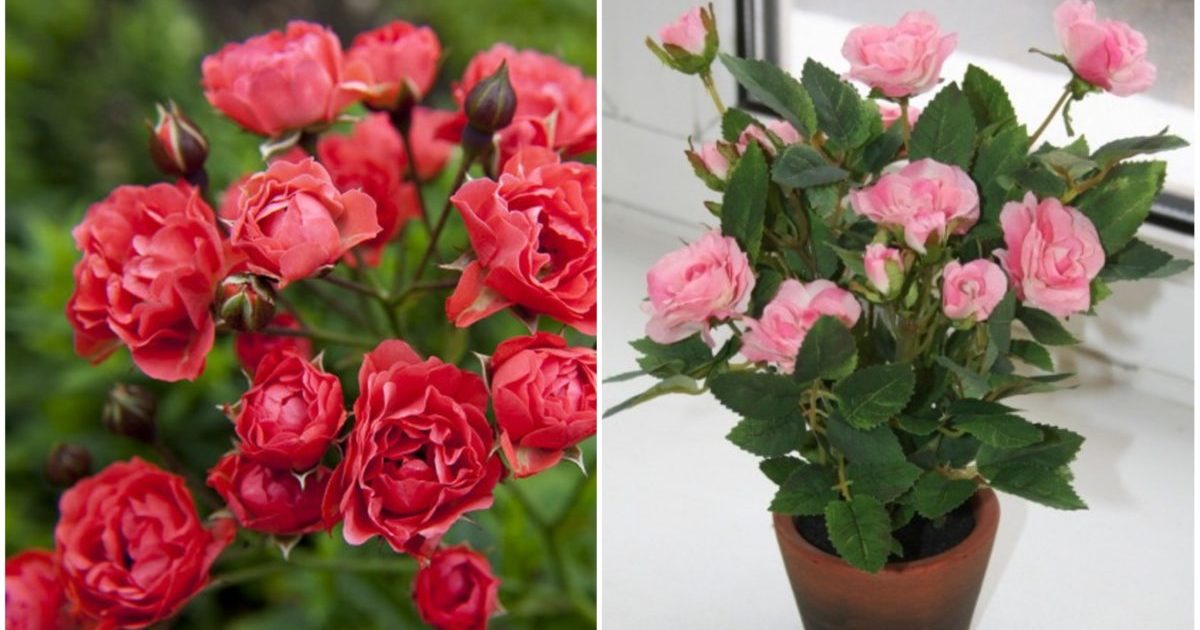
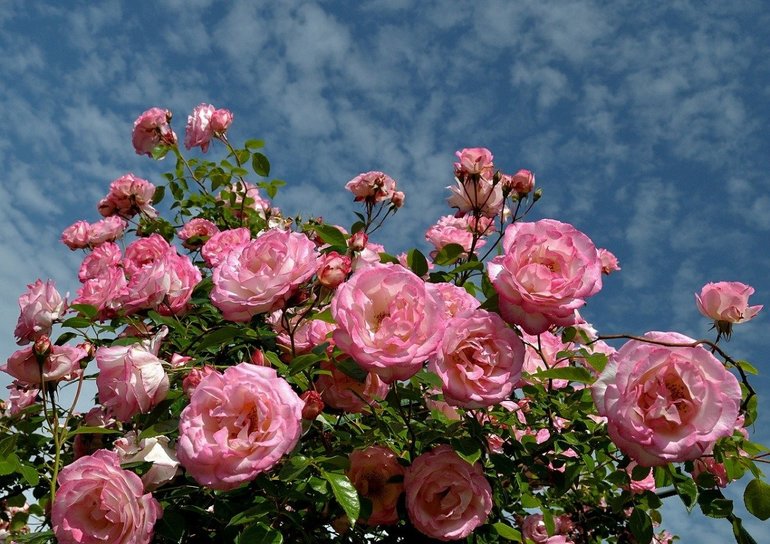
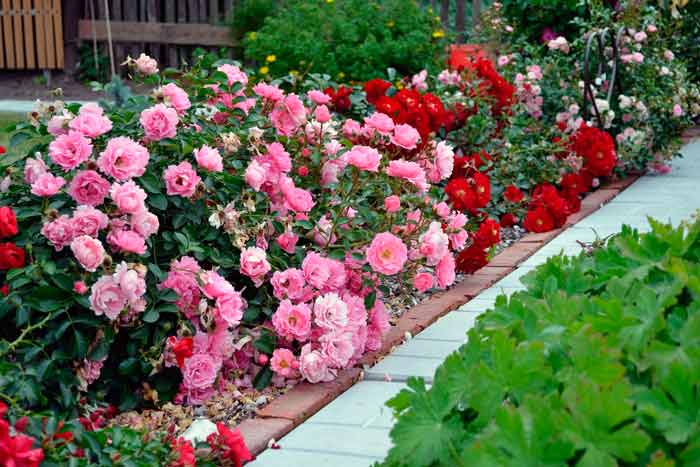 Shelter of roses for the winter: at what temperature does the robot hold
Shelter of roses for the winter: at what temperature does the robot hold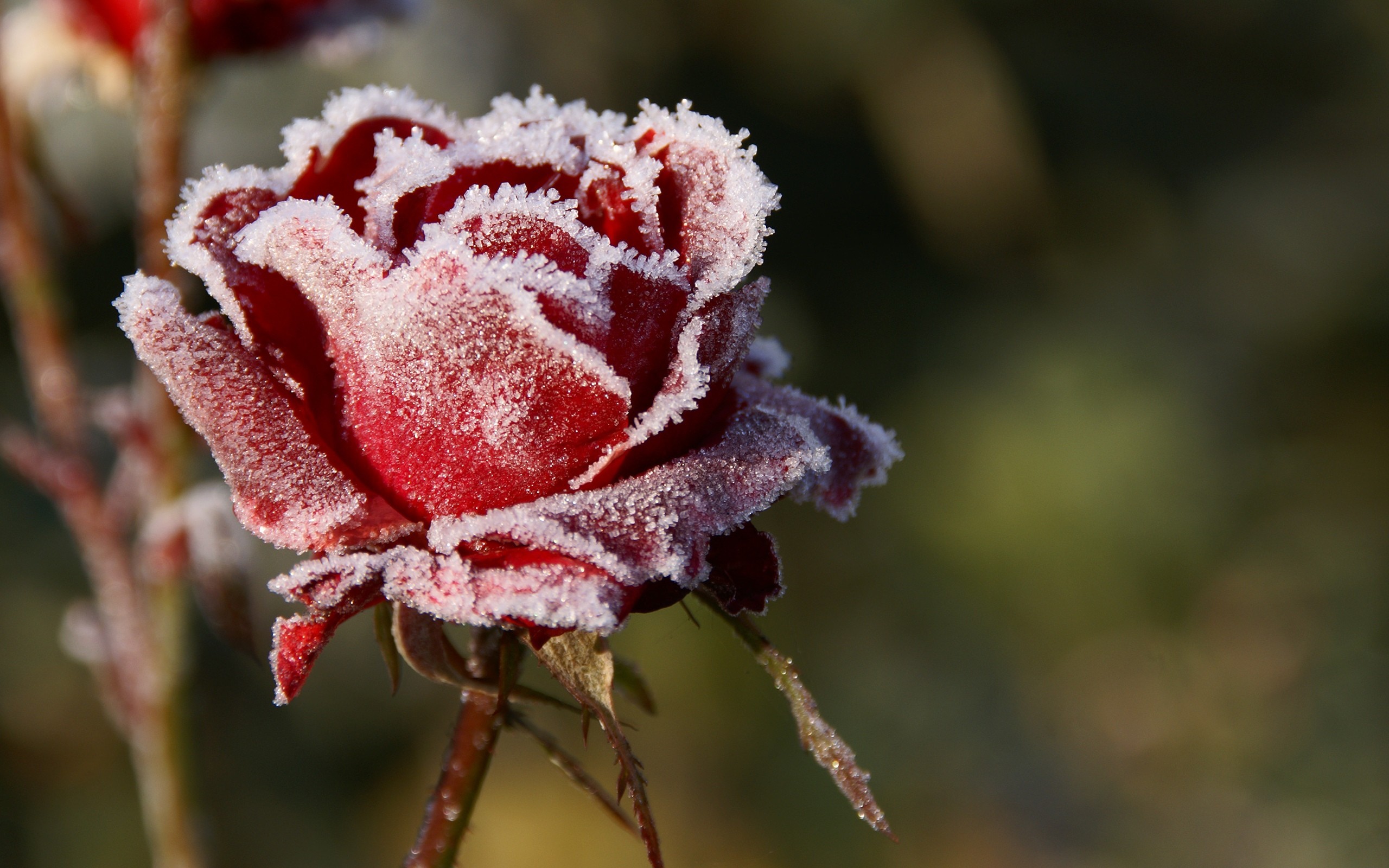 How to prune roses in the fall: timing, pruning rules, pros and cons
How to prune roses in the fall: timing, pruning rules, pros and cons What are the varieties and types of roses
What are the varieties and types of roses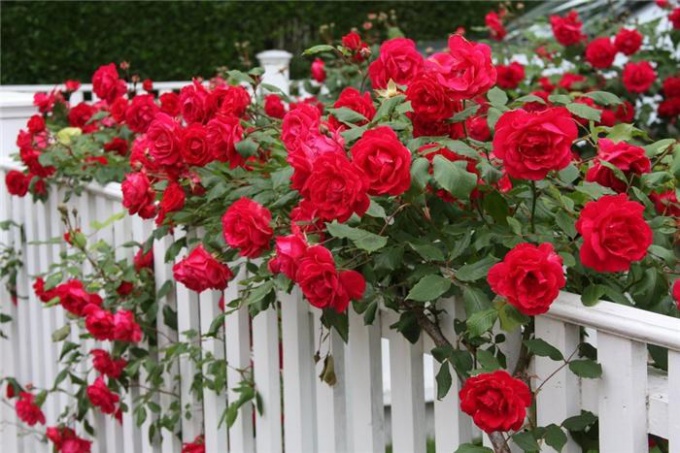 How to process roses with iron sulfate in autumn: proportions, advantages and disadvantages
How to process roses with iron sulfate in autumn: proportions, advantages and disadvantages